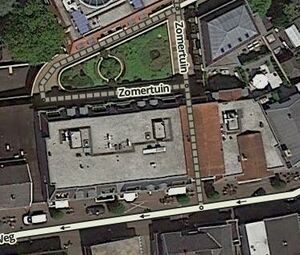Walking trail/en: verschil tussen versies
Geen bewerkingssamenvatting |
Geen bewerkingssamenvatting |
||
| Regel 5: | Regel 5: | ||
[[File:WME-WalkingTrail.jpg|top|right|300px]] | [[File:WME-WalkingTrail.jpg|top|right|300px]] | ||
Walking trail (WT) is one of the [[Non-drivable roads|non-drivable]] [[road types]]. Walking Trails are used for all 'roads' where cars are not able to drive but that can be a destination. Normally these are pedestrian areas.<br /> | Walking trail (WT) is one of the [[Non-drivable roads|non-drivable]] [[road types]]. Walking Trails are used for all 'roads' where cars are not able to drive but that can be a destination. Normally these are pedestrian areas.<br /> | ||
Always connect <i>Walking Trails</i>. They can be routable (considered for routing), Waze will stop routing at the start of the WT, where the Wazer should ideally park and finish on foot. Connecting can be done using a <i>[[Nodes|phantom node]]</i>.<br /> | Always connect <i>Walking Trails</i>. They can be routable (considered for routing), Waze will stop routing at the start of the WT, where the Wazer should ideally park and finish on foot. Connecting can be done using a <i>[[Nodes|phantom node]]</i>.<br /> | ||
Notice that this [[Road types|road type]] should only be applied when there are houses or other <i>destinations</i> along the segment ([[house numbers]]). | Notice that this [[Road types|road type]] should only be applied when there are houses or other <i>destinations</i> along the segment ([[house numbers]]). | ||
Also non-drivable [[Segments|segments]] necessary to reach a segment with <i>destinations</i> should be made <i>Walking trail</i> to get an uninterupted route from the drivable road to the </i>destinations</i>. | Also non-drivable [[Segments|segments]] necessary to reach a segment with <i>destinations</i> should be made <i>Walking trail</i> to get an uninterupted route from the drivable road to the </i>destinations</i>. | ||
For leading users to and from a parking lot place, [[Pedestrian Boardwalk|Pedestrian Boardwalks]] were used. Because of a bug this isn't working anymore: you should use now <i>Walking Trails</i>.<br> | For leading users to and from a parking lot place, [[Pedestrian Boardwalk|Pedestrian Boardwalks]] were used. Because of a bug this isn't working anymore: you should use now <i>Walking Trails</i>.<br> | ||
<i>Walking trails</i> are also useful because the house number is linked to the exact location of your destination. The end point of the route shown in the app is the starting point of the house number on the [[Segments|segment]]. Without WT you cannot see how far you still have to walk along the footpath. In addition, the length of the starting point is limited. So house numbers on long footpaths cannot be entered. | <i>Walking trails</i> are also useful because the house number is linked to the exact location of your destination. The end point of the route shown in the app is the starting point of the house number on the [[Segments|segment]]. Without WT you cannot see how far you still have to walk along the footpath. In addition, the length of the starting point is limited. So house numbers on long footpaths cannot be entered. | ||
The walking time is also included in the travel time calculation.<br> | The walking time is also included in the travel time calculation.<br> | ||
'''Attributes:''' | '''Attributes:''' | ||
{| class="wikitable" | {| class="wikitable" | ||
| Regel 41: | Regel 32: | ||
More on Walking trails and other non drivable road types, see the [[Non-drivable roads]] page.<br /> | More on Walking trails and other non drivable road types, see the [[Non-drivable roads]] page.<br /> | ||
More on locking, see the [[Non-drivable roads lock level]] page.<br /> | More on locking, see the [[Non-drivable roads lock level]] page.<br /> | ||
For more see the page on [[Road Aspects]]. | For more see the page on [[Road Aspects]]. | ||
Huidige versie van 30 mrt 2025 om 13:30
Walking Trail

Walking trail (WT) is one of the non-drivable road types. Walking Trails are used for all 'roads' where cars are not able to drive but that can be a destination. Normally these are pedestrian areas.
Always connect Walking Trails. They can be routable (considered for routing), Waze will stop routing at the start of the WT, where the Wazer should ideally park and finish on foot. Connecting can be done using a phantom node.
Notice that this road type should only be applied when there are houses or other destinations along the segment (house numbers). Also non-drivable segments necessary to reach a segment with destinations should be made Walking trail to get an uninterupted route from the drivable road to the destinations.
For leading users to and from a parking lot place, Pedestrian Boardwalks were used. Because of a bug this isn't working anymore: you should use now Walking Trails.
Walking trails are also useful because the house number is linked to the exact location of your destination. The end point of the route shown in the app is the starting point of the house number on the segment. Without WT you cannot see how far you still have to walk along the footpath. In addition, the length of the starting point is limited. So house numbers on long footpaths cannot be entered.
The walking time is also included in the travel time calculation.
Attributes:
| Street | City | Lock | |
|---|---|---|---|
| Pedestrean area |
More on Walking trails and other non drivable road types, see the Non-drivable roads page.
More on locking, see the Non-drivable roads lock level page.
For more see the page on Road Aspects.
Hoofdpagina | Index
